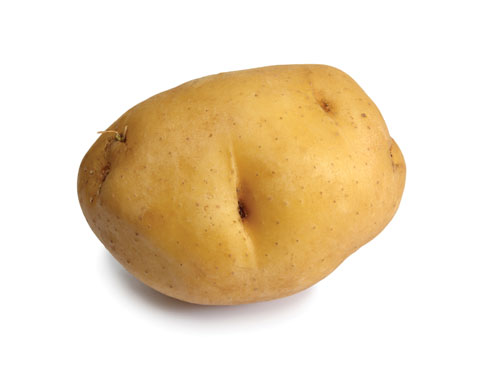
Michigan Fresh: Using, Storing, and Preserving Potatoes (HNI14)
DOWNLOADAugust 7, 2023 - Joyce McGarry and Laurie Messing, Michigan State University Extension
This Document is offered in: English, Arabic Espanol,

Food Safety and Storage
- Wash hands before and after handling fresh produce.
- Select potatoes that are firm and free of bruises, nicks or soft spots.
- Avoid choosing potatoes with sprouts and those with a green tinge.
- Scrub potatoes with a vegetable brush, under cool running Do not use soap.
- Store potatoes in a cool, dark place, preferably 45 to 50 °F, with good ventilation. When properly stored, potatoes will remain fresh for up to a month. Throw away potatoes that are shriveled or green or have many sprouts.
- Keep potatoes away from raw meat and meat juices to prevent cross-contamination.
- For best quality and nutritive value, preserve only what your family can consume in 12 months.
Yield
| One pound = |
3 medium potatoes 3 cups peeled and sliced 2 cups mashed 2 cups french fries |
| 20 pounds = | 7 quart cans |
| 13 Pounds = | 9 pint cans |
| 50 Pounds = | 18-22 quart cans |
How to Preserve
Canning
Pressure canning is the only safe method of canning potatoes. Potatoes must be pressure canned to avoid the potential of the foodborne illness botulism.
Use new white potatoes.
Select small to medium-sized mature potatoes. For packing whole, choose potatoes 1 to 2 inches in diameter.
- Hot pack method: Wash and peel potatoes. Cut into cubes, if desired. Place in a solution of 1 teaspoon ascorbic acid and 1 gallon water to prevent Drain before cooking. Place potatoes in saucepot of hot water, and bring to a boil. Boil whole potatoes for 10 minutes; boil cubes for 2 minutes. Drain. Pack hot potatoes in hot jars, leaving 1-inch headspace. Add ½ teaspoon salt to pints and 1 teaspoon to quarts, if desired. Fill jars to 1 inch from top with fresh boiling water. Remove air bubbles, wipe jar rims with a clean paper towel and adjust headspace if needed. Adjust lids and process (see tables that follow for recommended processing times).
|
Recommended process time (in minutes) for white potatoes in a dial-gauge pressure canner. |
||||||
|
|
|
Canner pressure (PSI) at altitudes of |
||||
|
Style of pack |
Jar size |
Process time |
0 – 2,000 ft |
2,001 – 4,000 ft |
4,001 – 6,000 ft |
6,001 – 8,000 ft |
|
Hot |
Pints |
35 |
11 lb. |
12 lb. |
13 lb. |
14 lb. |
|
Quarts |
40 |
11 lb. |
12 lb. |
13 lb. |
14 lb. |
|
|
Recommended process time (in minutes) for white potatoes in a weighted-gauge pressure canner. |
||||
|
|
Canner pressure (PSI) at altitudes of |
|||
|
Style of pack |
Jar size |
Process time |
0 – 1,000 ft |
Above 1,000 ft |
|
Hot |
Pints |
35 |
10 lb. |
15 lb. |
|
Quarts |
40 |
10 lb. |
15 lb. |
|
Let jars stand undisturbed for 12 to 24 hours, remove rings, wash jars, label, date and store. Food in jars that did not seal must be reprocessed within 24 hours in a clean jar with a new lid, refrigerated or frozen.
Tables were adapted from the National Center for Home Food Preservation (NCHFP), Selecting, Preparing and Canning Vegetables: Potatoes, White - Cubed or Whole¸ reviewed February 2018 (https://nchfp.uga.edu/how/can_04/potato_white.html), The NCHFP adapted them from the Complete Guide to Home Canning (Agriculture Information Bulletin, No. 539). USDA, 2015.
Freezing
Select smooth new Irish potatoes. Peel or scrape and wash. Water blanch* for 3 to 5 minutes depending on size. Cool in ice water for same 3- to 5-minute blanching time, drain and package, whole or sectioned, leaving ½-inch headspace. Seal, label, date and freeze.
*Water blanching: Use 1 gallon of water per pound of prepared potatoes. Put potatoes in blanching basket or colander and lower into boiling water. Place lid on blancher. Return water to boil and start counting blanching time as soon as water returns to a boil. It should take only a minute to come back to a boil. If it takes longer, too many potatoes have been put in the boiling water.
References
- Andress, E., & Harrison, J. A. (2014). So easy to preserve (Bulletin 989). (6th ed.). University of Georgia Cooperative Extension.
- National Center for Home Food Preservation. (2018, February). Selecting, preparing and canning vegetables: Potatoes, white - cubed or whole. https://nchfp.uga.edu/how/ can_04/potato_white.html
More information



 Print
Print Email
Email





